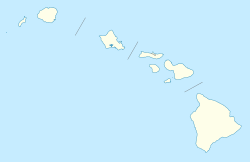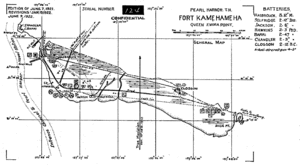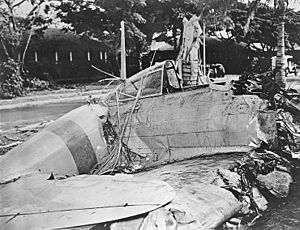Fort Kamehameha facts for kids
Quick facts for kids |
|
|
Battery Jackson
Battery Selfridge Battery Hasbrouck Battery Hawkins Hawkins annex |
|

Battery Hawkins
|
|
| Location | Honolulu, Hawaii |
|---|---|
| Built | 1913–1915 |
| MPS | Artillery District of Honolulu Thematic Resource |
| NRHP reference No. | 84000954 84000975 84000925 84000928 84000948 |
| Added to NRHP | June 5, 1984 |
Fort Kamehameha was a military base for the United States Army in Honolulu, Hawaii. It was built to protect Pearl Harbor with big guns, starting in 1907.
Contents
History of Fort Kamehameha
The land where Fort Kamehameha was built has a long history. The eastern part was once royal land, owned by Kamehameha I, the first king of the unified Hawaiian Islands. Later, it belonged to Bernice Pauahi Bishop and then to Samuel Mills Damon.
The western side was a beach estate owned by Queen Emma of Hawaii. This area was also used as a burial ground. The United States Army started using this land in 1901. The U.S. government officially took ownership in 1907. Sometimes, people called it "Queen Emma Military Reservation."
Back then, the United States Secretary of War, William Howard Taft, looked at how to defend important places like Hawaii. The fort was first named Fort Upton. But in 1909, local people wanted to honor Hawaii's history. So, the name was changed to Fort Kamehameha, after the great king.
First Big Guns: The Batteries
Fort Kamehameha had several areas with large guns, called "batteries." These batteries were built in phases, meaning they were added over time.
Battery Selfridge: Hiding Guns
Battery Selfridge was built between 1907 and 1913. It had two huge 12-inch guns. These guns were special because they were on "disappearing carriages." This meant they could pop up to fire and then lower back down to hide from enemy ships. They could shoot about 30 kilometers away! This battery was named after Lt. Thomas Selfridge.
Battery Jackson: Medium-Sized Guns
Battery Jackson was finished in 1913. It had two 6-inch guns, also on disappearing carriages. These guns could hit targets about 15 kilometers away. A very strong concrete air raid shelter was added here in 1915. Battery Jackson was named after General Richard H. Jackson.
Battery Hawkins: Smaller, Closer Guns
Battery Hawkins was built in 1914. It had two 3-inch guns, which were smaller but still powerful. They could shoot about 6 kilometers. There was also another bunker nearby called Hawkins annex. This battery was named after General Hamilton Smith Hawkins.
Battery Hasbrouck: Mortars for High Shots
Battery Hasbrouck was built from 1909 to 1914. It had eight 12-inch mortars. Mortars are guns that shoot shells high into the air, making them drop down on targets. These could also reach about 15 kilometers. This battery was right next to the entrance of Pearl Harbor. It was designed to protect the underwater minefield there. It was named after General Henry Cornelius Hasbrouck.
Batteries Chandler and Barri: Western Defenses
At the far west end of Fort Kamehameha, two more batteries were started in 1914. Battery Chandler had two 3-inch guns, named for Lt. Rex Chandler. Battery Barri had two 4.7-inch guns, named for Captain Thomas O. Barri. Battery Barri was taken apart in 1925, and neither of these batteries exist today.
Batteries Adair and Boyd: Guns on Ford Island
Two other batteries, Adair and Boyd, were built on Ford Island starting in 1916. Each had two 6-inch guns inside strong concrete rooms called "casemates." These batteries were named after Lt. Henry R. Adair and Captain Charles T. Boyd. Later, an airfield was built on Ford Island, and the Navy now owns the site.
Battery Closson: Modern Upgrades
The first guns at Fort Kamehameha became old-fashioned pretty quickly. So, in 1920, two new, very powerful 12-inch guns were installed. These guns were on a new type of mount that could turn a full 360 degrees. This battery was named Battery Closson, after General Henry Whitney Closson. These guns could fire a heavy shell about 27 kilometers!
To protect against attacks from the sky, anti-aircraft guns were also added. In 1942, more concrete was put over the guns for extra protection. A row of houses for officers was built in 1916, and a chapel was added in 1940.
Fort Kamehameha in Action
During World War II, some of the anti-aircraft guns at Fort Kamehameha were used during the attack on Pearl Harbor on December 7, 1941. A Japanese "Zero" airplane was shot down and crashed near the fort during this attack.
Preserving History
The big guns at Fort Kamehameha were only fired during practice, about once a year. They were taken apart and sold for scrap metal after World War II. Some parts of the fort were also destroyed.
Today, the area around Battery Selfridge and Battery Jackson is used by the Hawaii Air National Guard. The eastern side of the fort is now the Mamala Bay Golf Course.
Fort Kamehameha, as part of the "Artillery District of Honolulu," was added to the list of historic places in 1984. This means it's recognized as an important historical site.
In the 1970s, a wastewater treatment plant was built on the western end of the fort. In 1992, much of the fort's land became part of Hickam Air Force Base. Many historic homes on the base were left empty in 2008 because they were too close to the runway of the Honolulu International Airport.




